Best Practices for Cleaning Baseboards Effectively
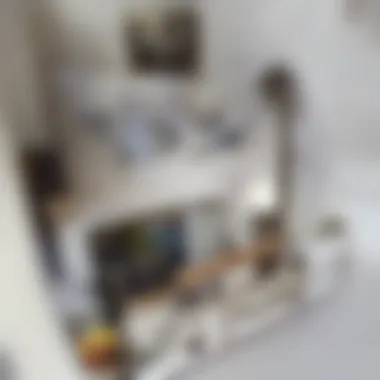

Intro
Featured Homes
Baseboards vary in style and finish depending on architectural styles. Understanding how to clean them effectively can differ based on the kind of home you have.
Architectural Styles
In modern homes, baseboards often have a minimalist design, usually made from MDF or wood. Older homes may feature more intricate designs carved from solid wood, requiring specialized care. The finish also plays a role; some homes may have painted baseboards, while others may have natural wood finishes that need to be treated differently.
Unique Design Elements
Beyond materials, the design elements of baseboards can enhance a home's character. For example, homes designed in the Victorian style may have ornate crown moldings that extend onto the baseboards. These elements require careful attention. Using the wrong cleaning product may damage the wood or ruin the paint, leading to costly repairs.
Essential Tools and Supplies
To clean baseboards effectively, certain tools and supplies are essential. This list covers what you need:
- Soft cloths or rags
- Vacuum with a baseboard attachment
- Cleaning solution suitable for your baseboard material
- A gentle scrub brush or toothbrush
- Protective gloves
Cleaning Techniques
Cleaning techniques will vary depending on the material of the baseboards. Here are some general steps:
- Dust First: Begin by removing loose dust with a cloth or vacuum. Pay attention to corners and crevices.
- Choose the Right Cleaner: Use a cleaning solution that suits your baseboard material, whether it is paint, wood, or another finish.
- Apply Solution: Dampen a cloth or sponge with the cleaner and wipe the baseboards. Avoid soaking the material.
- Scrub Gently: For stubborn stains, a gentle scrub can help. Use a soft brush or toothbrush if needed, but ensure you are cautious to avoid scratching the surface.
- Rinse and Dry: After cleaning, rinse your cloth and wipe down the baseboards with plain water to remove any residue. Finally, dry them to prevent moisture damage.
"Regular cleaning of baseboards contributes significantly to a home’s overall appearance and value."
Culmination
Caring for your baseboards is an integral part of home maintenance. By following the best practices discussed here, you can maintain the visual integrity of your interiors. Knowledge of materials and appropriate techniques will ensure your baseboards remain pristine over time.
Preface to Baseboard Cleaning
Cleaning baseboards is a vital aspect of maintaining a clean and organized home. Baseboards often gather dust, dirt, and grime. They act as barriers between walls and floors, but they are more than just functional elements. Well-maintained baseboards can enhance the overall aesthetic of a room. Therefore, understanding the best practices for baseboard cleaning is essential.
Importance of Baseboard Maintenance
Maintaining clean baseboards goes beyond simple aesthetics. Regular cleaning can prevent buildup of allergens, which is especially crucial for households with individuals suffering from allergies or respiratory conditions. Baseboards can trap dander, dust, and other irritants. A routine cleaning schedule not only reduces these irritants but also contributes to healthier indoor air quality. Furthermore, neglecting baseboard maintenance can lead to discoloration or damage over time, impacting both appearance and durability.
Another important consideration is the role of baseboards in protecting walls. They shield the lower part of the wall from scuffs, dents, and wear. When baseboards are not cleaned regularly, their protective function may diminish, exposing walls to potential damage, which in turn increases repair costs.
Common Challenges in Cleaning
Cleaning baseboards is not without its challenges. One major issue is accessibility. Baseboards can be difficult to reach, especially in tight corners or when furniture partially obstructs them. This can lead to inadequate cleaning and accumulation of grime over time.
Another common challenge is the variety of materials used in baseboards. Different materials, such as wood, vinyl, or MDF, each require specific cleaning methods and products. Using the wrong approach can damage the baseboards or render cleaning efforts ineffective.
Additionally, some homeowners struggle with stubborn stains or dirt that has accumulated over time. These tough spots may require more effort and different cleaning solutions. Not all products are suitable for every type of baseboard, leading to confusion about which products to use.
Ultimately, understanding these challenges can help in developing effective cleaning strategies. Recognizing the specific needs of different baseboards can lead to successful maintenance that preserves both their functionality and appearance.
Understanding Different Types of Baseboards
Understanding the different types of baseboards is crucial for effective maintenance and cleaning. Each material used in baseboards has its own characteristics, which affect how dirt and grime accumulate and how easily they can be cleaned. Familiarity with these materials helps homeowners and enthusiastic cleaners choose the right cleaning methods and products. For instance, wood baseboards require caution due to their susceptibility to moisture and damage from harsh chemicals. In contrast, vinyl baseboards are often more resistant but can still benefit from specific cleaning approaches. Thus, knowing your baseboard type is fundamental for preserving their aesthetics and extending their lifespan.
Wood Baseboards
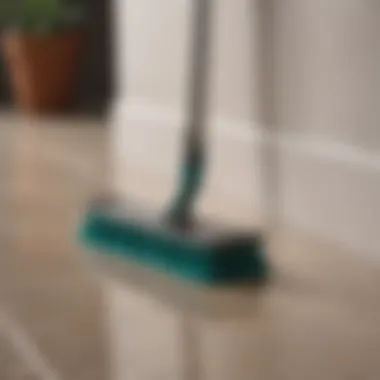
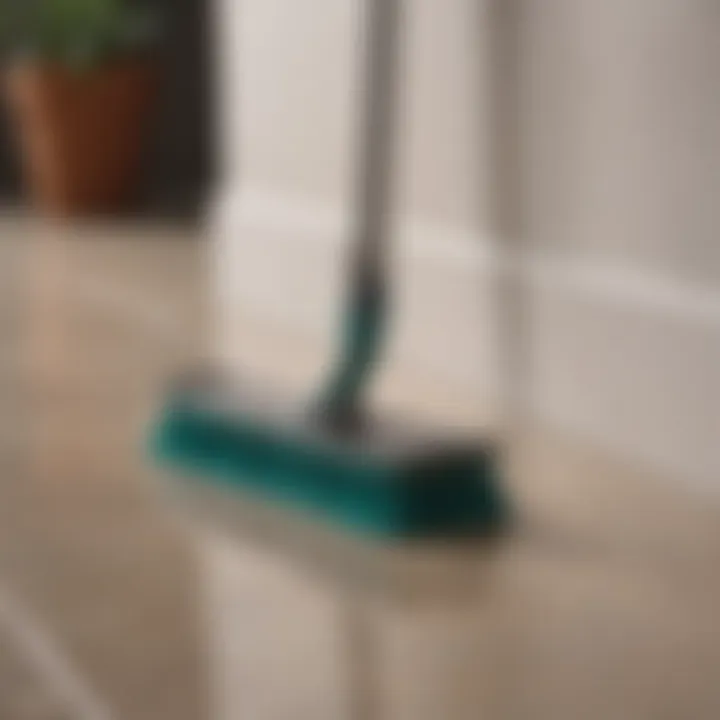
Wood baseboards are a popular choice for many homes. They provide an elegant finish that enhances the room's decor. However, cleaning wood baseboards requires a nuanced approach. Wood can absorb liquids, making it essential to use minimal moisture when cleaning. A solution made of mild soap and water often suffices. Avoid harsh chemical cleaners that can strip the protective finishes off the wood.
When cleaning, a soft-bristled brush or a gentle microfiber cloth should be used to avoid scratches. It is also advisable to dust regularly to prevent buildup. If the wood baseboards have specific finishes, it may be prudent to check the manufacturer's recommendations for cleaning to avoid any damage.
Vinyl Baseboards
Vinyl baseboards are valued for their durability and ease of maintenance. They resist moisture and can handle a variety of cleaning solutions without being easily damaged. For typical cleaning, a simple mixture of warm water and mild detergent will do. A sponge or cloth can be employed to wipe them down effectively.
The main benefit of vinyl is its resilience; however, it can attract dirt in high-traffic areas. Regular cleaning helps maintain their appearance and prevents discoloration. In addition, beware of using abrasive tools, as they may scratch and damage the surface.
MDF and Composite Baseboards
MDF, or Medium-Density Fiberboard, along with composite materials, are increasingly common in many homes. These materials offer the look of wood at a lower cost, which is attractive for budget-conscious homeowners. However, MDF is sensitive to moisture and can warp if exposed to excessive water. Like wood, cleaning these baseboards involves using a damp cloth with a gentle cleaner.
It's advisable to avoid soaking them as it can lead to deterioration of the material. Using a vacuum cleaner with an appropriate attachment can effectively remove dirt before applying any cleaners. Though they are relative newcomers in the world of baseboards, proper cleaning and maintenance will ensure they remain an aesthetically pleasing element of home decor.
Essential Cleaning Supplies
Cleaning baseboards effectively requires the right tools and solutions. The quality of cleaning supplies can significantly influence the overall outcome of your cleaning efforts. Using appropriate tools ensures that dirt and grime are removed without damaging the baseboards themselves. It also makes the cleaning process more efficient, minimizing time and effort.
Basic Cleaning Tools
Microfiber Cloths
Microfiber cloths are essential for baseboard cleaning. These cloths capture dust, dirt, and allergens effectively. Their key characteristic is the fine fibers that enhance cleaning performance. Microfiber is also a popular choice because it can absorb up to seven times its weight in water.
A unique feature of microfiber cloths is that they do not scratch surfaces. This is crucial when cleaning painted or delicate finishes on baseboards. They are durable, washable and can be used repeatedly, making them cost-effective as well.
Advantages include:
- Excellent dust trapping ability.
- Reusable and easy to wash.
- Gentle on surfaces.
Disadvantages are minimal, although improper washing can reduce their effectiveness. For optimal results, avoid using fabric softeners when laundering.
Soft-Bristled Brushes
Soft-bristled brushes are another vital tool for cleaning baseboards. Their design allows for effective scrubbing without risking damage to softer materials. The key characteristic of these brushes is their ability to reach into crevices and remove stubborn dirt.
Choosing a soft-bristled brush is beneficial as it provides a balance between scrubbing power and gentleness. A unique aspect of these brushes is that they can be used with various cleaning solutions without fear of scratching the surface.
Advantages include:
- Effective for stubborn dirt.
- Versatile for various surfaces.
- Gentle enough for delicate finishes.
However, the limitation could be that they might not remove fine dust as easily as microfiber cloths. Thus, they are often used in conjunction with other tools.
Vacuum Cleaner Attachments
Vacuum cleaner attachments serve an essential purpose in baseboard cleaning. They come with specialized heads designed to fit into narrow spaces and corners. This is crucial for effective cleaning, as baseboards often gather dust and debris in areas that are hard to reach.
The key characteristic of these attachments is their design, which allows for deep cleaning without disturbing surrounding areas. Using a vacuum cleaner attachment is a popular choice due to its efficiency in removing dirt without the need for scrubbing.
Key advantages include:
- Speed and efficiency in cleaning.
- Easy access to hard-to-reach areas.
- Reduction of manual effort in cleaning.
Some disadvantages include the need for a compatible vacuum and potential noise during operation. However, their benefits usually outweigh these downsides.
Cleaning Solutions


Homemade Cleaners
Homemade cleaners offer an eco-friendly alternative for cleaning baseboards. They usually consist of common household items like vinegar, baking soda, and lemon juice. Their key characteristic is that they are safe for the environment and may cost less than commercial products.
The unique feature of homemade cleaners is the ability to customize them based on personal preferences and specific cleaning needs. This can be advantageous, particularly for those concerned with chemical exposure.
Advantages include:
- Non-toxic ingredients.
- Cost-effective solutions.
- Customization to tackle specific cleaning tasks.
The downside can be inconsistency in results. Some may not perform as well as commercial alternatives, especially for heavy-duty cleaning.
Commercial Products
Commercial products for cleaning baseboards can be a practical choice for those seeking convenience. They are widely available and formulated specifically for various surfaces. The key characteristic of these products is their effectiveness in cutting through grime quickly and efficiently.
The unique feature of many commercial products is that they often have added components to prevent buildup and enhance shine. This makes them a popular option for individuals looking for low-effort cleaning solutions.
Advantages include:
- Fast and effective cleaning.
- Specially formulated to address various surfaces.
- Convenience in use.
However, potential disadvantages could include exposure to chemicals and higher costs than homemade options. It is important to select products based on the specific material of the baseboard to avoid damage.
Regularly assess the solutions you choose, ensuring they align with your cleaning goals and the types of surfaces you are maintaining.
Step-by-Step Cleaning Techniques
Cleaning baseboards requires specific methodologies to ensure that they are not only aesthetically pleasing but also free from dirt and allergens. These techniques provide a clear path for maintaining baseboards, enhancing their longevity and appearance. Adopting a systematic approach helps prevent potential damage while ensuring every corner is addressed. This contributes to an overall cleaner living environment and promotes better indoor air quality.
Dusting and Initial Preparation
Before engaging in more intensive cleaning processes, appropriate preparation is essential. Initial dusting removes loose dust and debris, preventing these particles from becoming embedded or spread further during deep cleaning. Start by selecting an appropriate tool, such as a microfiber cloth or a soft-bristled brush. These tools are gentle yet effective.
Ensure that you select a time of day when natural light can help you inspect the baseboards closely, allowing you to spot missed areas easily. Do not forget to remove any furniture or obstacles that may hinder access. This preparation sets the tone for an effective cleaning process, enhancing efficiency.
Deep Cleaning Process
The deep cleaning of baseboards involves a more thorough approach, focusing on both the application of a suitable cleaning solution and effective scrubbing techniques to eradicate stubborn stains and grime.
Applying Cleaning Solution
The application of a cleaning solution is a crucial step when maintaining baseboards. A good cleaning solution, whether homemade or commercial, effectively breaks down dirt and grease. This is why it is considered beneficial in the cleaning process. For instance, a mixture of warm water and vinegar is recognized for its natural disinfectant properties.
Another option is to use a mild commercial all-purpose cleaner specifically designed for wood or vinyl finishes. Always read labels carefully to avoid potential damage to the baseboard finishes. This consideration is key because the wrong solution can cause discoloration or warping.
Determining the right solution often comes down to the material of the baseboard. Thus, ensuring knowledge of the specific cleaning requirements is necessary.
Scrubbing Techniques
Once the cleaning solution is applied, effective scrubbing techniques come into play. Using a soft-bristled brush or a sponge is advisable, as they provide enough abrasion to dislodge dirt without damaging the baseboard. Movement should be strategic, focusing on corners and crevices where dirt may accumulate more easily.
Employing a consistent pattern, such as working from one end of the baseboard to the other, helps ensure no areas are overlooked. This technique encourages thoroughness, maximizing the cleaning effect.
While scrubbing, pay attention to areas that may have more extensive buildup, especially around the lower sections of the baseboard. Noting these spots can help in future cleaning sessions.
Drying and Finishing
After deep cleaning, it is critical to dry the baseboards adequately. Moisture left on surfaces can lead to mold growth or warping over time. Use a clean, dry microfiber cloth to remove any lingering moisture. Ensure the area is well-ventilated to expedite the drying process. Once the baseboards are dry, inspect them again for any missed spots or areas that may need further attention.
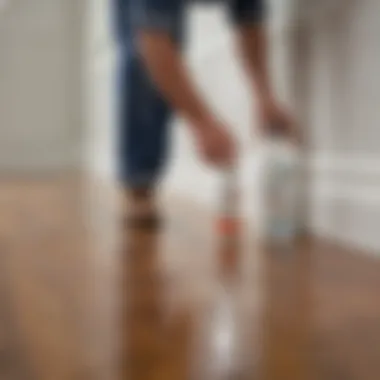
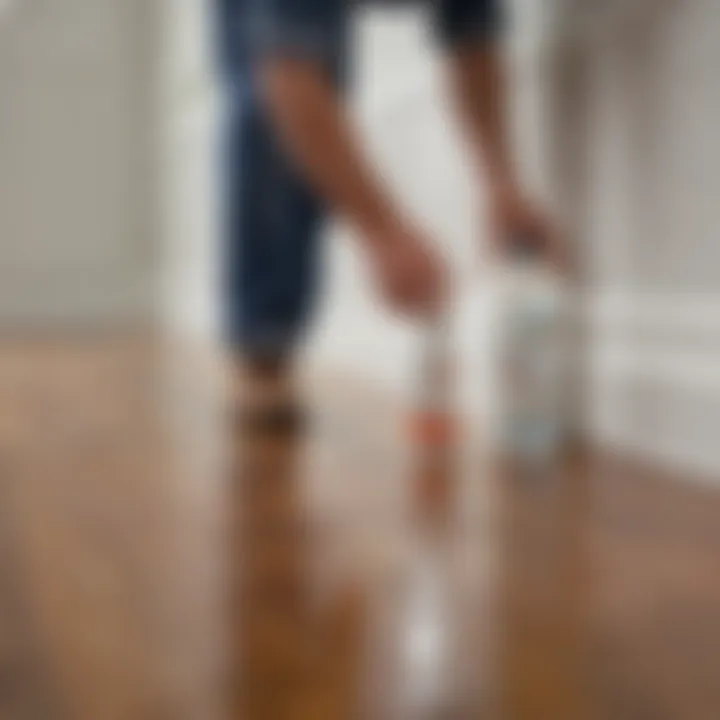
Taking these extra steps not only improves the look of baseboards but also reinforces their durability. A consistent cleaning routine, coupled with these techniques, will keep baseboards in optimal condition.
Preventive Maintenance Tips
Preventive maintenance is crucial for the longevity and appearance of baseboards in any home. Baseboards often go unnoticed until dirt and grime accumulate. By implementing a consistent cleaning regimen, homeowners can avoid more intensive cleaning sessions later. Preventive measures not only save time but also help maintain the integrity of the materials, reducing wear and tear over time. Here are some specific elements and benefits of preventive maintenance for baseboards:
- Enhances Aesthetic Appeal: Regular cleaning keeps baseboards looking new and fresh, contributing to the overall look of the home.
- Protects against Damage: Dirt and dust can scratch or wear down the finish on wood or vinyl baseboards if left unattended. Regular maintenance helps to mitigate these risks.
- Promotes Health: Accumulated dust can contribute to allergies. Keeping baseboards clean can improve air quality.
Maintaining a careful approach to baseboard care can significantly ease the cleaning process and prolong the material's lifespan.
Regular Dusting Schedule
Creating a regular dusting schedule is one of the simplest yet most effective practices for baseboard maintenance. Estabishing a routine helps in preventing dirt build-up. Here are some steps to consider when developing this schedule:
- Frequency: Dusting should be performed at least once every two weeks. In high-traffic areas or homes with pets, it may be necessary to increase this frequency to once a week.
- Timing: Choose a specific day for cleaning, integrating it into your weekly household chores. This makes it less of a burden and more of a habit.
- Tools: Use a microfiber cloth or a soft-bristled brush to gently remove dust from the baseboards. Avoid harsh materials that may scratch or damage the surface.
In addition, make sure to check for cobwebs or specific stains during dusting, as addressing these issues early can prevent larger cleaning challenges later.
Protective Measures
Implementing protective measures can help in preserving the condition of your baseboards. There are several methods to consider. Here are some worthwhile strategies:
- Barrier Solutions: Using furniture pads and rubber mats reduce the risk of scuffs and scratches.
- Regular Checks: Periodically inspect baseboards for signs of damage, such as chips or warping. Early detection allows for timely repairs before the issue escalates.
- Avoid Excessive Moisture: This is particularly important for wood and MDF baseboards. Ensure that floors are mopped dry and spills are cleaned promptly.
"Regular attention to baseboards not only preserves their function but also uplifts the visual integrity of your living space."
Employing these preventive maintenance strategies can facilitate a care regime that protects the value of your home. The objective is simple: a proactive approach leads to efficient upkeep and a more pleasant living environment.
Special Considerations for Different Environments
Cleaning baseboards may seem like a straightforward task, but specific conditions can greatly impact the cleaning process and the materials used. Understanding these nuances can enhance the effectiveness of your efforts and prolong the life of your baseboards. Addressing the unique demands of environments like high-humidity spaces or homes with pets ensures thorough maintenance and preserves aesthetic appeal. By adapting your cleaning techniques to different situations, you can meet the requirements of each setting.
Cleaning Baseboards in High-Humidity Areas
High-humidity areas present particular challenges when cleaning baseboards. Common locations such as bathrooms, kitchens, and laundry rooms tend to trap moisture, which can foster mold and mildew growth on wooden and MDF baseboards. Here are key factors to consider:
- Mold prevention: Regularly inspect baseboards for any signs of mold or mildew. Use a solution of diluted bleach or a commercial mold cleaner for stubborn spots, following it up with a thorough rinse and drying.
- Cleaning frequency: Increase the frequency of cleaning in these areas. A monthly schedule may be more effective in preventing buildup and deterioration.
- Choosing the right cleaning products: Opt for solutions designed for mildew removal when doing your routine cleaning. Avoid overly harsh chemicals that might damage the finish of your baseboards.
"In high-humidity environments, it's wise to prioritize both cleanliness and preventative measures to maintain the integrity of the surface materials."
Maintaining Baseboards in Homes with Pets
Homes populated by pets require diligent care for baseboards due to the presence of fur, dander, and occasional accidents. These factors can result in an accumulation of dirt and pathogens, which necessitates a different cleaning approach:
- Regular fur removal: Use a vacuum cleaner with the appropriate attachment to straight out baseboards regularly. This helps remove loose hair and prevents the buildup of dander.
- Immediate clean-up: Accidents happen. Quick response to any spills or messes can prevent stains and odors from settling into both carpets and baseboards.
- Pet-safe cleaning products: Opt for cleaners that are safe for pets. Many commercial products contain harsh chemicals that could harm your furry friends. Consider homemade solutions using vinegar or baking soda for a gentle yet effective clean.
- Routine check-ups: Periodically assess the condition of your baseboards for scratches or wear from pets. This can involve light sanding and refinishing if necessary.
Epilogue
Cleaning baseboards is not merely a chore; it plays a critical role in maintaining the overall aesthetics and hygiene of a home. With proper practices, homeowners can ensure their baseboards complement rather than detract from their interiors. The techniques outlined in this article are designed to be practical and effective, catering to various materials. This approach prioritizes the longevity and cleanliness of baseboards, which can often be overlooked during regular cleaning routines.
Summary of Best Practices
- Regular Maintenance: Establishing a routine for dusting and cleaning prevents buildup and makes deeper cleaning simpler.
- Choosing the Right Tools: Using appropriate cleaning supplies, such as microfiber cloths and soft-bristled brushes, ensures that no harm comes to the baseboard material.
- Applying Suitable Cleaning Solutions: Selecting between homemade and commercial cleaners based on the material type can optimize results.
- Techniques for Different Situations: Whether in high-humidity areas or homes with pets, adapting methods to the conditions will promote better upkeep.
Implementing these practices will greatly enhance the cleanliness and appearance of baseboards. This not only improves the home environment, it also reflects care and attention from its occupants.
Final Thoughts on Baseboard Care
In closing, baseboard care should not be underestimated. They serve as the boundary between walls and floors and influence the perceived cleanliness of a space. The time and effort invested in their maintenance yield significant rewards, including improved visual appeal and the prevention of long-term damage.
As you approach the task of cleaning baseboards, remember the following:
- Clean gradually and systematically.
- Be mindful of the specific needs based on the baseboard material.
- Establish a consistent cleaning schedule to keep dirt and dust at bay.
These considerations will promote not only the aesthetic aspect of your home but also contribute positively to its overall value and livability.















